
| Version | Summary | Created by | Modification | Content Size | Created at | Operation |
|---|---|---|---|---|---|---|
| 1 | Azlin Fazlina Osman | -- | 3614 | 2022-07-22 06:17:42 | | | |
| 2 | Jessie Wu | Meta information modification | 3614 | 2022-08-05 10:16:25 | | | | |
| 3 | Jessie Wu | Meta information modification | 3614 | 2022-08-05 10:18:29 | | | | |
| 4 | Jessie Wu | Meta information modification | 3614 | 2022-08-08 08:46:17 | | |
Video Upload Options
Polymers are being used in many applications all around the world. However, there are some drawbacks in the properties of polymers that could hamper their usage in certain applications. Therefore, a new material polymer composite was introduced. A polymer composite is a polymer-based material with the addition of a filler. Many researchers have reported the improvement in the properties of a polymer when a filler was introduced. This helps minimize the disadvantages of using a polymer. Fillers are materials added to resins or binders (polymer/concrete/metal/ceramic) to improve their specific properties as they are turned into a new form of material called a “composite.” Dolomite is a type of sedimentary carbonate rock that consists mainly of dolomite mineral. The use of dolomite in a polymer composite system has gained increasing attention in recent years after researchers successfully proved that it is capable of improving mechanical and physical properties of various polymeric materials.
1. Dolomite
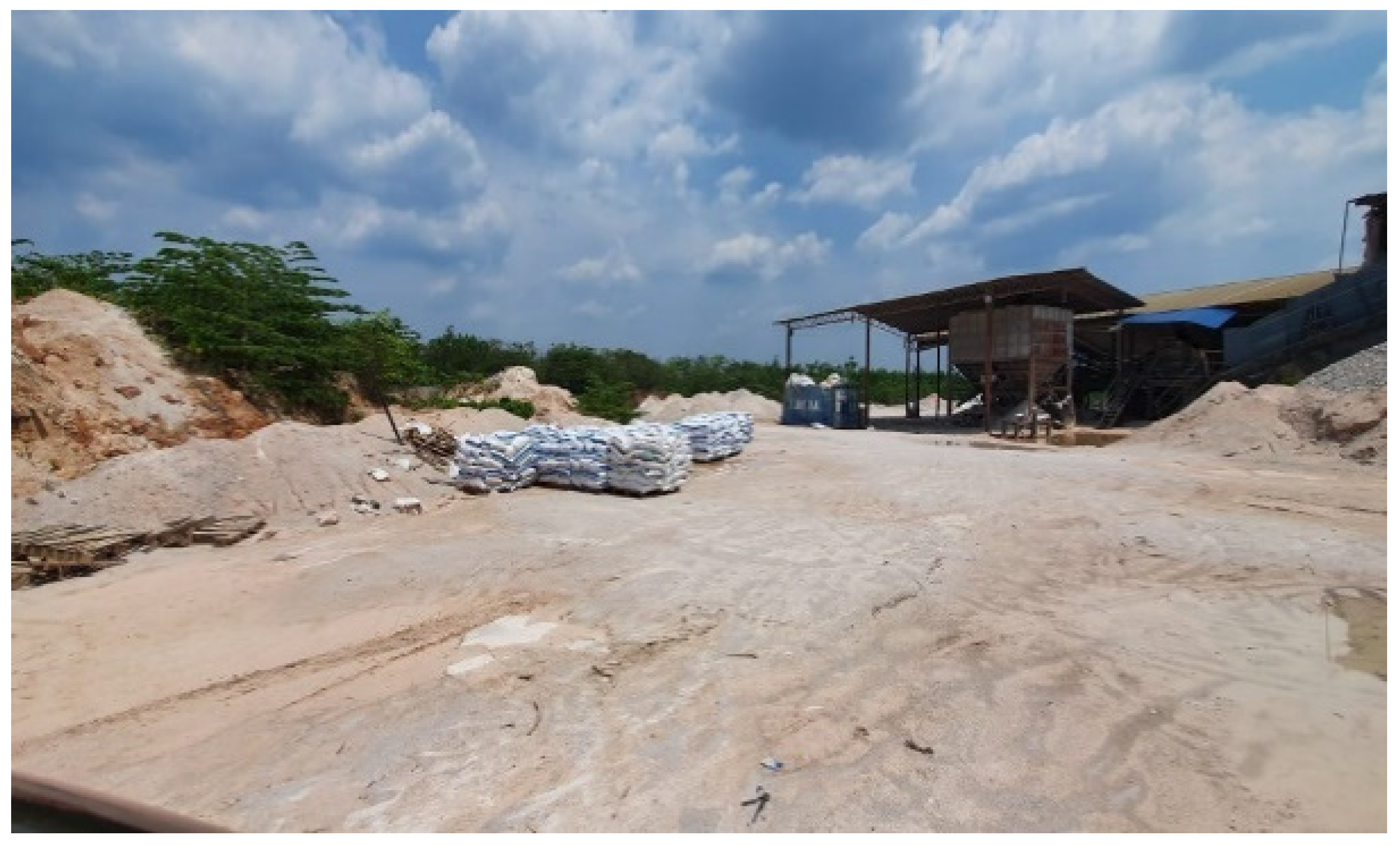
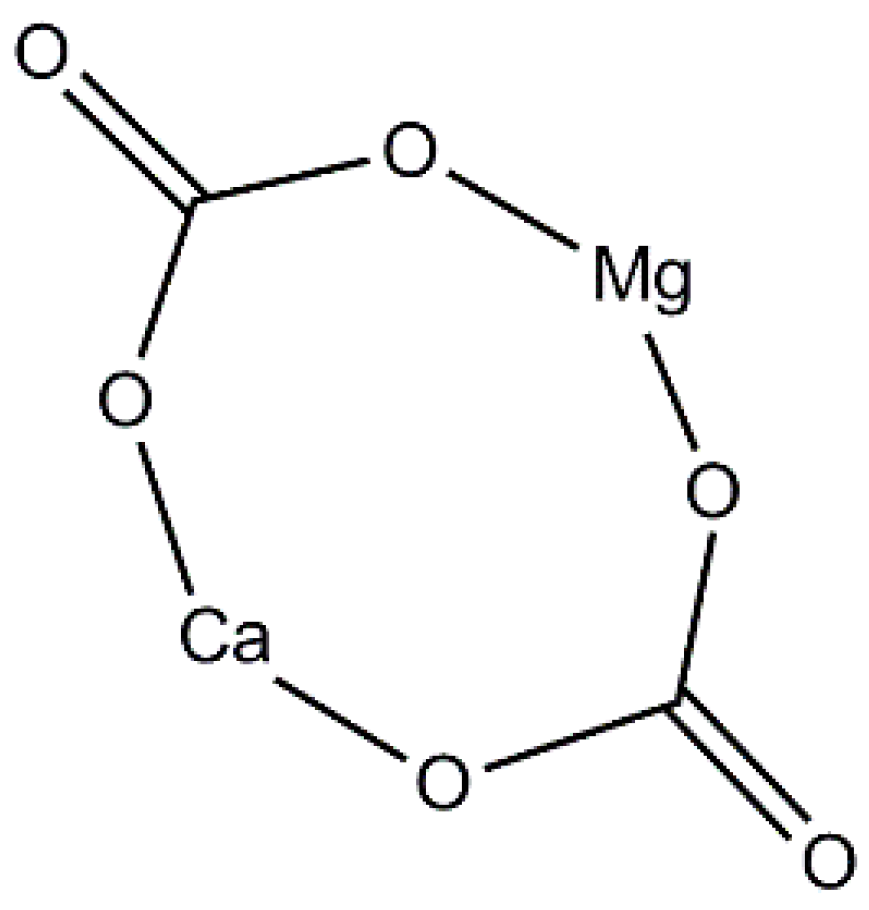
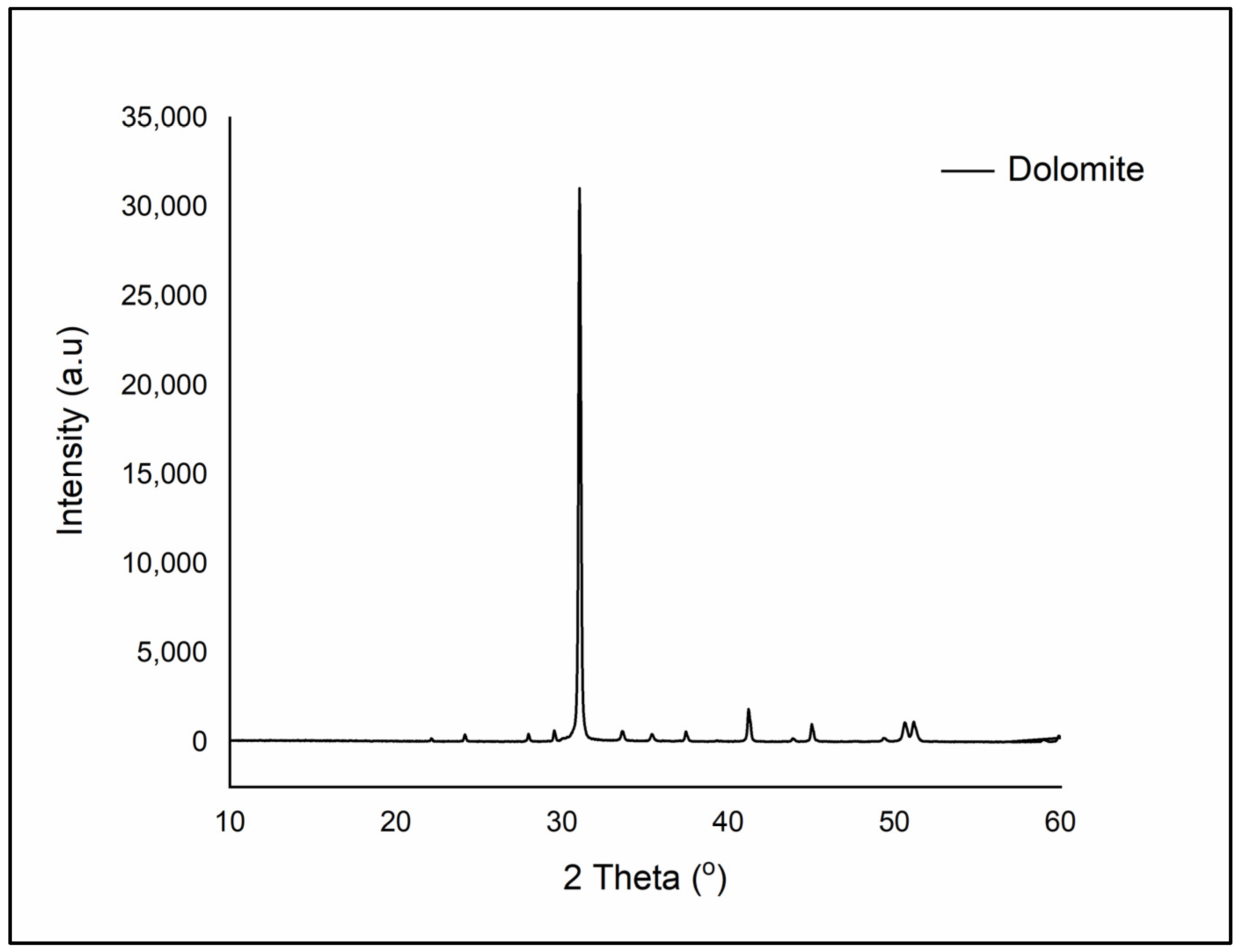

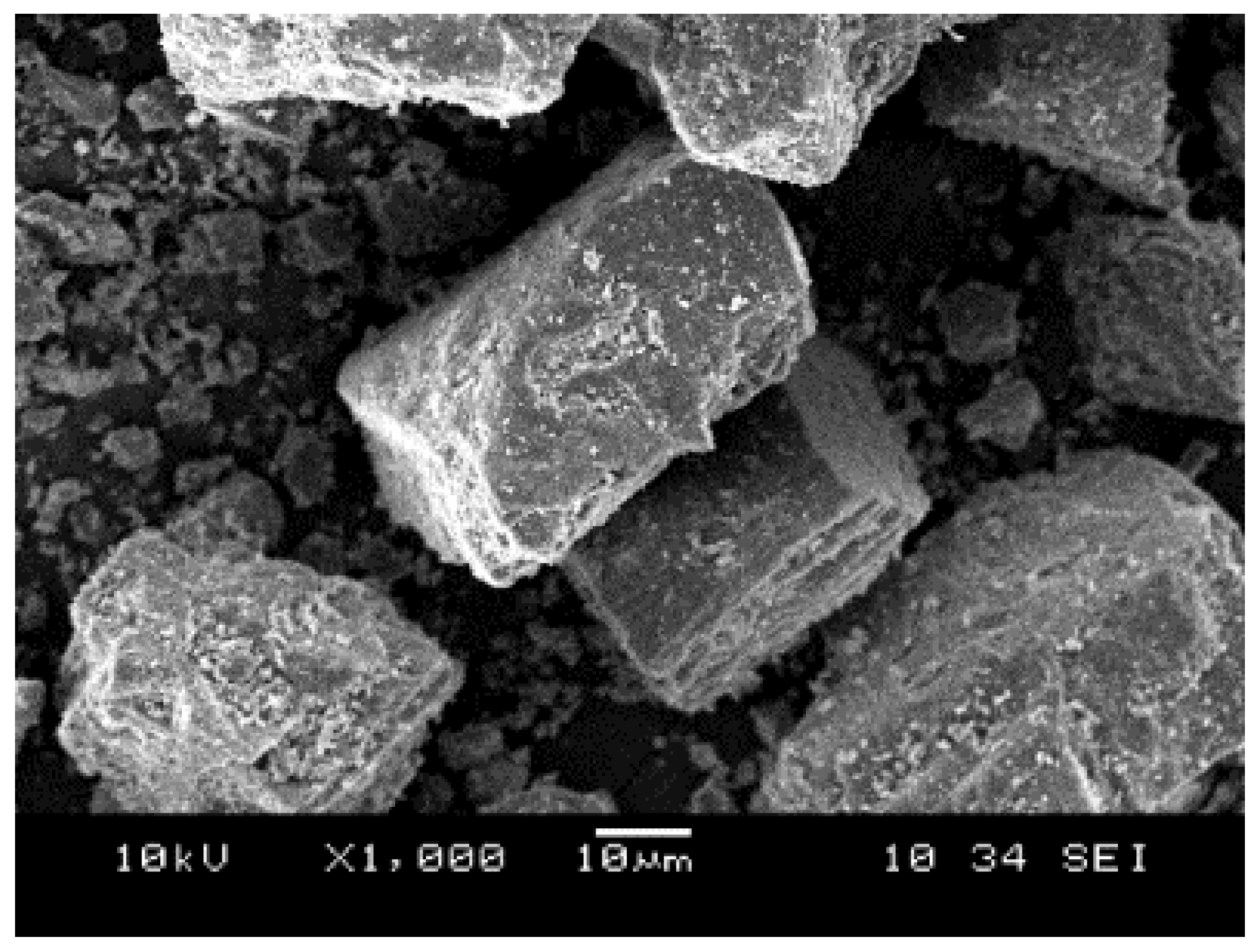
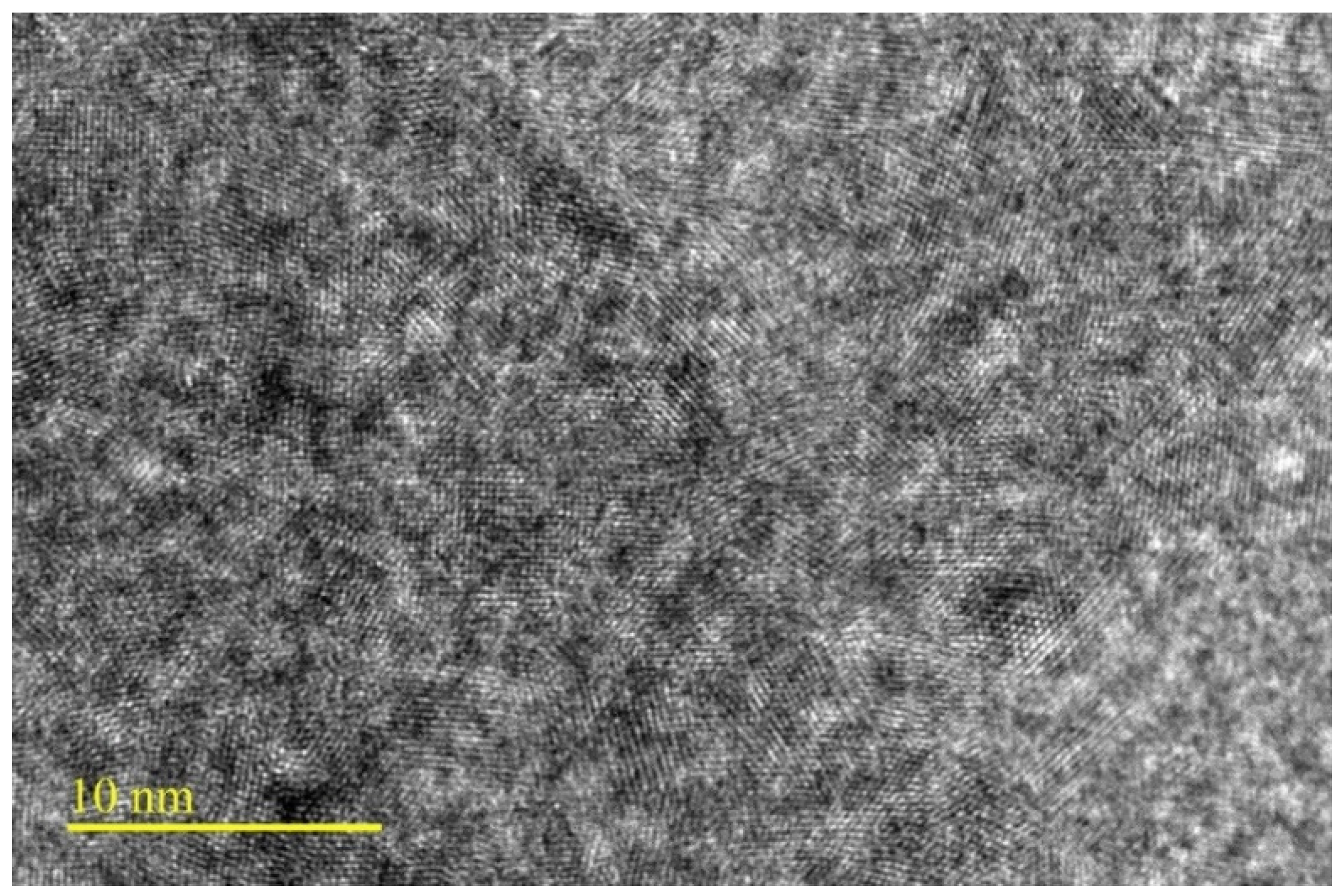
| Physical Properties | Dolomite [15] | Calcite [16] |
|---|---|---|
| Chemical composition | (CaMg(CO3)2) | CaCO3 |
| Color | Colorless, white, pink, gray, brown, black | White, colorless, gray, red, green, blue, yellow, orange, brown |
| Streak | White | White |
| Cleavage | Perfect, rhombohedral, three directions | Perfect, rhombohedral, three directions |
| Mohs hardness | 3.5–4 | 3 |
| Specific gravity | 2.8–2.9 | 2.7 |
| Diagnostic properties | Rhombohedral cleavage | Rhombohedral cleavage |
| Crystal system | Hexagonal | Trigonal |
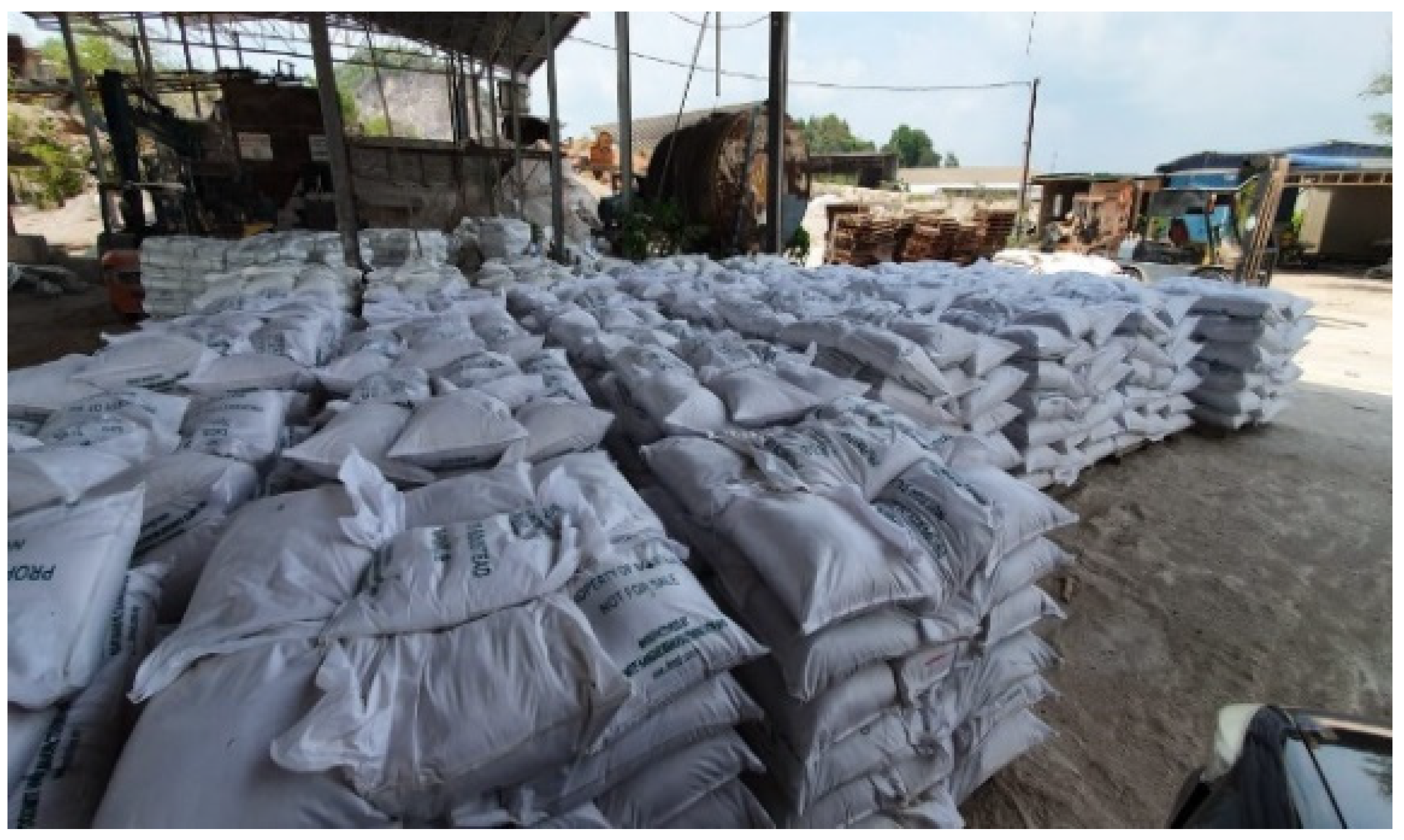
| Field | Purpose |
|---|---|
| Agriculture | As fertilizer [17] To decrease the acidity of soil [19] To adjust magnesium concentration in soil [19] |
| Aquaculture | To reduce phosphorus [21] |
| Ceramics | As a source of lime [9] In kiln control [17] |
| Chemical | To make salts, e.g., magnesia [22] |
| Construction | In cement and concrete manufacturing [17][20][23] As flooring material [3][24] As road construction material [24][25] |
| Plastic for structural application | As a filler [4] |
| Paint | As a filler [26] As an aid in pigmentation [27] |
| Wastewater treatment | For copper ion adsorption [5] |
| Membrane application | As low-cost membranes or substrates [28] |
| Plastics | As a filler to improve the mechanical properties [29][30] |
| Pharmaceutical | As a supplementary source of calcium and magnesium [31] As an osmotic oral laxative [31] |
2. Dolomite as a Hybrid Filler in a Polymer Composite
| Polymer Matrix | Primary Filler | Secondary Filler | Processing Method | Filler Loading | Tensile | Elongation at Break (%) | Impact Strength | Hardness | Flexural | Ref. | |||
|---|---|---|---|---|---|---|---|---|---|---|---|---|---|
| Strength (MPa) | Modulus | Stress (MPa) | Strength (MPa) | Modulus (MPa) | |||||||||
| Epoxy resin | Carbon nanotubes (CNTs) | Dolomite | Mechanical stirrer | Chemical vapor deposition | [37] | ||||||||
| 0% | 20.89 | 961.31 (MPa) | N/A | N/A | N/A | N/A | N/A | N/A | |||||
| 1% | 28.52 | 1152.87 (MPa) | N/A | N/A | N/A | N/A | N/A | N/A | |||||
| 3% | 33.83 | 1188.1 (MPa) | N/A | N/A | N/A | N/A | N/A | N/A | |||||
| 5% | 4.93 | 1216.5 (MPa) | N/A | N/A | N/A | N/A | N/A | N/A | |||||
| Physically hybrid | |||||||||||||
| 0% | 20.89 | 961.31 (MPa) | N/A | N/A | N/A | N/A | N/A | N/A | |||||
| 1% | 26.71 | 1139 (MPa) | N/A | N/A | N/A | N/A | N/A | N/A | |||||
| 3% | 29.97 | 1159.8 (MPa) | N/A | N/A | N/A | N/A | N/A | N/A | |||||
| 5% | 27.94 | 1148.7 (MPa) | N/A | N/A | N/A | N/A | N/A | N/A | |||||
| Epoxy resin | Glass fiber | Dolomite | Hand layup | 0% | 59.8 | N/A | N/A | N/A | 2.4 (J) | 102.12 (HRL) | 72.3 | N/A | [38] |
| 5% | 52 | N/A | N/A | N/A | 2.7 (J) | 107.27 (HRL) | 62.8 | N/A | |||||
| 10% | 45.9 | N/A | N/A | N/A | 3.4 (J) | 109.60 (HRL) | 54.3 | N/A | |||||
| 15% | 42.8 | N/A | N/A | N/A | 3.8 (J) | 112.26 (HRL) | 48..8 | N/A | |||||
| Epoxy resin | Glass fiber | Dolomite | Hand layup | 0% | 282.58 ± 12.96 | 2.32 ± 0.14 (GPa) | N/A | N/A | 6.1 ± 0.37 (J) | 101.32 ± 3.08 (HV) | 285.3 ± 13.12 | N/A | [39] |
| 5% | 268.59 ± 9.43 | 2.94 ± 0.l5 (GPa) | N/A | N/A | 7.2 ± 0.36 (J) | 103.76 ± 2.89 (HV) | 273 ± 9.65 | N/A | |||||
| 10% | 244.69 ± 7.80 | 3.26 ± 0.13 (GPa) | N/A | N/A | 8.8 ± 0.35 (J) | 105.64 ± 3.23 (HV) | 262.8 ± 7.12 | N/A | |||||
| 15% | 227.6 ± 7.10 | 2.44 ± 0.10 (GPa) | N/A | N/A | 10.2 ± 0.41 (J) | 108.22 ± 2.3 (HV) | 249.9 ± 7.24 | N/A | |||||
| VTRM | 0% | 374.46 ± 17.80 | 3.54 ± 0.21 (GPa) | N/A | N/A | 8.1 ± 0.46 (J) | 102.94 ± 3.18 (HV) | 337.4 ± 14.25 | N/A | ||||
| 5% | 337.33 ± 10.80 | 4.15 ± 0.17 (GPa) | N/A | N/A | 9.2 ± 0.37 (J) | 106.3 ± 225 (HV) | 331.8 ± 10.12 | N/A | |||||
| 10% | 293.05 ± 11.65 | 4.33 ± 0.22 (GPa) | N/A | N/A | 10.6 ± 0.48 (J) | 109.06 ± 3.08 (HV) | 327.6 ± 12.38 | N/A | |||||
| 15% | 270.43 ± 7.12 | 4.02 ± 0.12 (GPa) | N/A | N/A | 13.4 ± 0.39 (J) | 112.08 ± 2.38 (HV) | 319.9 ± 7.60 | N/A | |||||
| Low-density polyethylene (LDPE) | Kenaf core fiber (KCF) | Dolomite | Internal mixer | 0% | N/A | 109.37 (MPa) | 1.47 | N/A | 3.52 (kJ/m2) | N/A | N/A | N/A | [40] |
| 3% | N/A | 116.72 (MPa) | 1.50 | N/A | 3.73 (kJ/m2) | N/A | N/A | N/A | |||||
| 6% | N/A | 122.52 (MPa) | 1.53 | N/A | 3.82 (kJ/m2) | N/A | N/A | N/A | |||||
| 9% | N/A | 123.48 (MPa) | 1.60 | N/A | 4.03 (kJ/m2) | N/A | N/A | N/A | |||||
| 12% | N/A | 124.50 (MPa) | 1.81 | N/A | 4.11 (kJ/m2) | N/A | N/A | N/A | |||||
| 15% | N/A | 131.30 (MPa) | 1.86 | N/A | 4.69 (kJ/m2) | N/A | N/A | N/A | |||||
| 18% | N/A | 143.46 (MPa) | 1.91 | N/A | 5.29 (kJ/m2) | N/A | N/A | N/A | |||||
| Phenolic | Dolomite | Multiwalled carbon nanotubes (MWCNTs) | Ball milling machine | 0% | N/A | N/A | N/A | N/A | N/A | 25(HR) | N/A | N/A | [41] |
| 1% | N/A | N/A | N/A | N/A | N/A | 36(HR) | N/A | N/A | |||||
| 3% | N/A | N/A | N/A | N/A | N/A | 45(HR) | N/A | N/A | |||||
| 5% | N/A | N/A | N/A | N/A | N/A | 52(HR) | N/A | N/A | |||||
| Phenolic | Dolomite | Carbon nanotubes (CNTs) | Mechanical stirrer | Chemical vapor deposition | [42] | ||||||||
| 0 | N/A | N/A | N/A | N/A | N/A | 25 | N/A | N/A | |||||
| 1 | N/A | N/A | N/A | N/A | N/A | 39 | N/A | N/A | |||||
| 3 | N/A | N/A | N/A | N/A | N/A | 46 | N/A | N/A | |||||
| 5 | N/A | N/A | N/A | N/A | N/A | 50 | N/A | N/A | |||||
| Physically hybrid | |||||||||||||
| 0 | N/A | N/A | N/A | N/A | N/A | 25 | N/A | N/A | |||||
| 1 | N/A | N/A | N/A | N/A | N/A | 30 | N/A | N/A | |||||
| 3 | N/A | N/A | N/A | N/A | N/A | 37 | N/A | N/A | |||||
| 5 | N/A | N/A | N/A | N/A | N/A | 38 | N/A | N/A | |||||
| Waterborne polyurethane (WPU) | Fibrous palygorskite (PAL) | Dolomite | Mechanical stirring | 0% | 4.9 | N/A | N/A | 9.4 | N/A | N/A | N/A | N/A | [10] |
| WPU/PAL10% | 3.5 | N/A | N/A | 8.8 | N/A | N/A | N/A | N/A | |||||
| WPU/DOL 10% | 4. | N/A | N/A | 9.5 | N/A | N/A | N/A | N/A | |||||
| WPU/MIX 10% | 8. | N/A | N/A | 8.1 | N/A | N/A | N/A | N/A | |||||
| Polypropylene (PP) | Wood flour | Dolomite | High-intensity mixer and single-screw extruder | 0% | 27.1 | 474 (MPa) | N/A | 29.4 | N/A | N/A | 37.1 | 1013 | [43] |
| 3% | 24.8 | 615 (MPa) | N/A | 20.1 | N/A | N/A | 42.4 | 1592 | |||||
| 6% | 24.4 | 620 (MPa) | N/A | 22.2 | N/A | N/A | 41.0 | 1617 | |||||
| 9% | 22.8 | 627 (MPa) | N/A | 19.4 | N/A | N/A | 41.8 | 1673 | |||||
References
- Mehmood, M. Dolomite and Dolomitization Model—A Short Review. Int. J. Hydrol. 2018, 2, 549–553.
- Banerjee, A. Estimation of Dolomite Formation: Dolomite Precipitation and Dolomitization. J. Geol. Soc. India 2016, 87, 561–572.
- Hussin, K.; Jamaludin, S.; Mohd, C.; Ghazali, R.; Idris, S.; Salleh, N.; Nizar, K. The Development of Artificial Marble from Dolomite (Batu Reput) in Perlis. KUKUM Eng. Res. Semin. 2006, 101–106.
- Adesakin, A.O.; Ajayi, O.O.; Imosili, P.E.; Attahdaniel, B.E.; Olusunle, S.O.O. Characterization and Evaluation of Mechanical Properties of Dolomite as Filler in Polyester. Chem. Mater. Res. 2013, 3, 36–40.
- Cao, Z.; Chen, P.; Yang, F.; Wang, S.; Zhong, H. Transforming Structure of Dolomite to Enhance Its Ion-Exchange Capacity for Copper (II). Colloids Surf. A Physicochem. Eng. Asp. 2018, 539, 201–208.
- Nik Nur Azza, N.A.; Ong, H.L.; Noorina Hidayu, J.; Akil, H.M.; Sam, S.T. Analysis of Ground Dolomite: Effect of Grinding Time on the Production of Submicron Particles. Appl. Mech. Mater. 2014, 679, 145–148.
- Ridhwan, J.N.M.; Noimam, N.Z.; Mohd Salleh, M.A.A.; Sam, S.T.; Musa, L.; Nik Yahya, N.Z. The Effect of Different Sizes “Batu Reput” (Dolomite) as a Filler in SMR L and ENR-50. Adv. Mater. Res. 2013, 795, 383–387.
- Salleh, M.N.; Kasim, F.H.; Ismail, K.N.; Ghazali, C.M.R.; Saad, S.A.; DAud, S. Characterization and Application of Dolomite Rock in Perlis. In Proceedings of the 1st International Conference on Natural Resources Engineering & Technology 2006, Putrajaya, Malaysia, 24–25 July 2006; pp. 465–470.
- Tengku Mustafa, T.N.A.S.; Munusamy, S.R.R.; Uy Lan, D.N.; Yunos, N.F.M. Physical and Structural Transformations of Perlis Carbonate Rocks via Mechanical Activation Route. Procedia Chem. 2016, 19, 673–680.
- Ni, L.; Mao, Y.; Liu, Y.; Cai, P.; Jiang, X.; Gao, X.; Cheng, X.; Chen, J. Synergistic Reinforcement of Waterborne Polyurethane Films Using Palygorskite and Dolomite as Micro/Nano-Fillers. J. Polym. Res. 2020, 27, 23.
- Gregg, J.M.; Bish, D.L.; Kaczmarek, S.E.; Machel, H.G. Mineralogy, Nucleation and Growth of Dolomite in the Laboratory and Sedimentary Environment: A Review. Sedimentology 2015, 62, 1749–1769.
- Abdul Samad, H.; Abd Rashid, R. Influence of Dolomite and Granite Waste Content on the Properties of Artificial Marble. IOP Conf. Ser. Mater. Sci. Eng. 2020, 713, 012017.
- Perlis Dolomite Industries. Available online: https://www.perlisdolomite.com.my/?playlist=30d262f&video=2f0c00c (accessed on 26 June 2022).
- Iqbal, Y.; Leu, L.-C.; Fahad, M.; Ubic, R. Characterization of Mineral Ores from Northern and Northwest Pakistan. JOM 2012, 65, 73–79.
- Dolomite Mineral Physical—Optical Properties, Occurrence and Uses. Available online: https://geologyscience.com/minerals/dolomite/ (accessed on 26 June 2022).
- Calcite Mineral|Uses and Properties. Available online: https://geology.com/minerals/calcite.shtml (accessed on 26 June 2022).
- Abdalqader, A.; Sonebi, M. Dolomitic Filler in Self-Compacting Concrete: A Review. RILEM Tech. Lett. 2020, 5, 75–84.
- Murtaja, Y.; Lapčík, L.; Sepetcioglu, H.; Vlček, J.; Lapčíková, B.; Ovsík, M.; Staněk, M. Enhancement of the mechanical properties of HDPE mineral nanocomposites by filler particles modulation of the matrix plastic/elastic behavior. Nanotechnol. Rev. 2022, 11, 312–320.
- Karaca, S.; Gurses, A.; Ejder, M.; Acikyildiz, M. Adsorptive Removal of Phosphate from Aqueous Solutions Using Raw and Calcinated Dolomite. J. Hazard. Mater. 2006, 128, 273–279.
- Ye, H.; Fu, C.; Yang, G. Influence of Dolomite on the Properties and Microstructure of Alkali-Activated Slag with and without Pulverized Fly Ash. Cem. Concr. Compos. 2019, 103, 224–232.
- Kavitha, M.; Linga, D.; Adhikari, S.; Anikuttan, K.; Prabu, D. Effect of Lime, Dolomite and Gypsum on Phosphorus Reduction Potential in Freshwater. Int. J. Appl. Pure Sci. Agric. 2016, 2, 44–50.
- Wonyen, D.G.; Kromah, V.; Gibson, B.; Nah, S.; Chelgani, S.C. A Review of Flotation Separation of Mg Carbonates (Dolomite and Magnesite). Minerals 2018, 8, 354.
- John, V.M.; Damineli, B.L.; Quattrone, M.; Pileggi, R.G. Fillers in Cementitious Materials—Experience, Recent Advances and Future Potential. Cem. Concr. Res. 2018, 114, 65–78.
- Hamizah, A.S.; Rashita, A.R.; Malek, S. Characterization and Evaluation of Dolomite and Kaolin as Filler on the Properties of Poly Art Marble. Mater. Today Proc. 2020, 29, 173–178.
- Haritonovs, V.; Tihonovs, J.; Smirnovs, J. High Modulus Asphalt Concrete with Dolomite Aggregates. Transp. Res. Procedia 2016, 14, 3485–3492.
- Solihin; Sulistiyono, E. Synthesis of Magnesium Carbonate Using Indonesian Dolomite. Adv. Mater. Res. 2015, 1112, 546–549.
- Youssef, E.A.M. Characterization, surface modification, and evaluation of Egyptian dolomite ore as an extender pigment for paint. Pigment. Resin Technol. 2002, 31, 226–233.
- Bessa, L.P.; Terra, N.M.; Cardoso, V.L.; Reis, M.H.M. Macro-Porous Dolomite Hollow Fibers Sintered at Different Temperatures toward Widened Applications. Ceram. Int. 2017, 43, 16283–16291.
- Osman, A.F.; Siah, L.; Alrashdi, A.A.; Ul-Hamid, A.; Ibrahim, I. Improving the Tensile and Tear Properties of Thermoplastic Starch/Dolomite Biocomposite Film through Sonication Process. Polymers 2021, 13, 274.
- Lim, K.C.; Osman, A.F.; Ahmad Fauzi, A.A.; Alrashdi, A.A.; Abdul Halim, K.A. The Mechanical and Thermal Properties of Poly(Ethylene-Co-Vinyl Acetate) (PECoVA) Composites with Pristine Dolomite and Organophilic Microcrystalline Dolomite (OMCD). Polymers 2021, 13, 3034.
- Mohamed El-Mezayen, A.; Mohamed Saleh, G.; Mohamed Abdou El-Desoky, H.; Mohd Said Khalil, B.; Samy, A.M. Mineralogical and Chemical Studies on Some Minerals Used in Pharmaceuticl Industries in Egypt. Al-Azhar J. Pharm. Sci. 2014, 50, 181–190.
- Saba, N.; Tahir, P.; Jawaid, M. A Review on Potentiality of Nano Filler/Natural Fiber Filled Polymer Hybrid Composites. Polymers 2014, 6, 2247–2273.
- Przekop, R.E.; Jakubowska, P.; Sztorch, B.; Kozera, R.; Dydek, K.; Jałbrzykowski, M.; Osiecki, T.; Marciniak, P.; Martyła, A.; Kloziński, A.; et al. Opoka—Sediment Rock as New Type of Hybrid Mineral Filler for Polymer Composites. AppliedChem 2021, 1, 90–110.
- Kumar, A.; Sharma, K.; Dixit, A.R. A Review of the Mechanical and Thermal Properties of Graphene and Its Hybrid Polymer Nanocomposites for Structural Applications. J. Mater. Sci. 2018, 54, 5992–6026.
- Matykiewicz, D.; Barczewski, M.; Mousa, M.S.; Sanjay, M.R.; Siengchin, S. Impact Strength of Hybrid Epoxy–Basalt Composites Modified with Mineral and Natural Fillers. ChemEngineering 2021, 5, 56.
- Jaafar, M. Development of Hybrid Fillers/Polymer Nanocomposites for Electronic Applications. In Hybrid Nanomaterials: Advances in Energy, Environment and Polymer Nanocomposites; Kumar Srivastava, S., Mittal, V., Eds.; Scrivener Publishing: Beverly, MA, USA, 2017; pp. 349–369.
- Saleh, S.S.M.; Wei, Y.S.; Mohammad, N.F.; Abdullah, S.F.A.; Akil, H.M.; Saliu, H.R. Tensile Properties of CNTs-Dolomite Hybrid Filled Epoxy Composites. In Proceedings of the AIP Conference Proceedings, Ariyalur, India, 29 June 2021; AIP Publishing LLC: Melville, NY, USA, 2021.
- Verma, S.K.; Gupta, A.; Singh, T.; Gangil, B.; Jánosi, E.; Fekete, G. Influence of Dolomite on Mechanical, Physical and Erosive Wear Properties of Natural-Synthetic Fiber Reinforced Epoxy Composites. Mater. Res. Express 2019, 6, 125704.
- Verma, S.K.; Gangil, B.; Gupta, A.; Rajput, N.S.; Singh, T. Dolomite Dust Filled Glass Fiber Reinforced Epoxy Composite: Influence of Fabrication Techniques on Physicomechanical and Erosion Wear Properties. Polym. Compos. 2021, 43, 551–565.
- Shamsuri, A.A.; Mohd Zolkepli, M.N.; Mohamed Ariff, A.H.; Sudari, A.K.; Abu Zarin, M. A Preliminary Investigation on Processing, Mechanical and Thermal Properties of Polyethylene/Kenaf Biocomposites with Dolomite Added as Secondary Filler. J. Compos. 2015, 2015, 760909.
- Saleh, S.S.M.; Akil, H.M.; Abdul Kudus, M.H.; Zakaria, M.R. A comparative Study of Dolomite and MWCNTS-Dolomite as Fillers in Phenolic Composites. Malays. Polym. J. 2014, 9, 67–69.
- Saleh, S.S.M.; Akil, H.M.; Abdul Kudus, M.H.; Ahmad, K.R.; Ahmad Bakhtiar, N.S.A. Effect of Different Hybrid Method on Properties of Carbon Nanotubes/Dolomite Hybrid Filled Phenolic Composites. Procedia Chem. 2016, 19, 45–49.
- Özdemir, E.; Ayrilmis, N.; Mengeloglu, F. Effect of Dolomite Powder on Combustion and Technological Properties of WPC and Neat Polyproppylene. J. Chil. Chem. Soc. 2017, 62, 3716–3720.
- Gangil, B.; Ranakoti, L.; Verma, S.K.; Singh, T. Utilization of Waste Dolomite Dust in Carbon Fiber Reinforced Vinylester Composites. J. Mater. Res. Technol. 2022, 18, 3291–3301.
- Amiri, R.-S.N.; Tirri, T.; Wilen, C.-E. Flame Retardant Polyurethane Nanocomposite: Study of Clay Dispersion and Its Synergistic Effect with Dolomite. J. Appl. Polym. Sci. 2012, 129, 1678–1685.
- Vijayaraghavan, J.; Jeevakkumar, R.; Venkatesan, G.; Rengasamy, M.; Thivya, J. Influence of Kaolin and Dolomite as Filler on Bond Strength of Polyurethane Coated Reinforcement Concrete. Constr. Build. Mater. 2022, 325, 126675.




